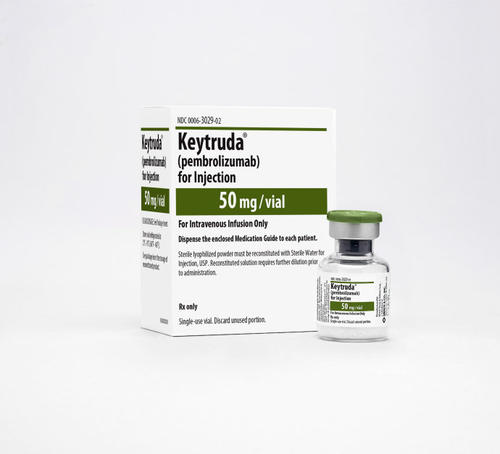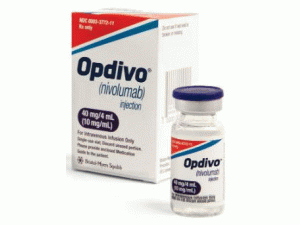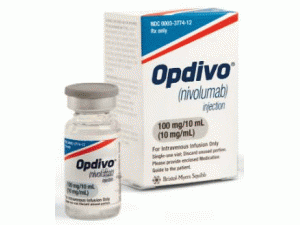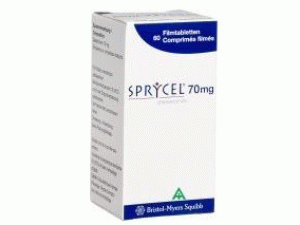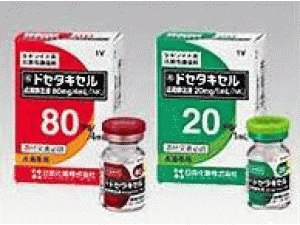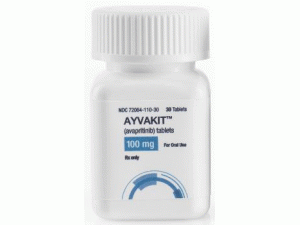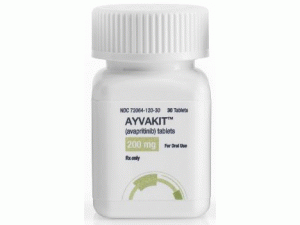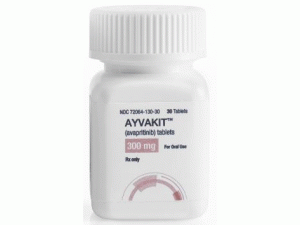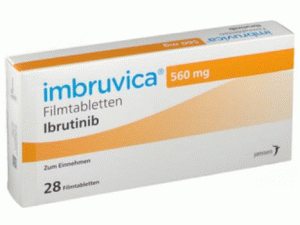托西莫单抗BEXXAR(Tositumomab)
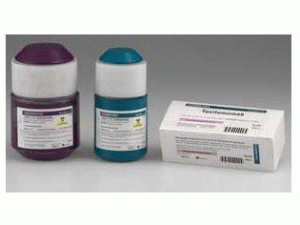 产地国家:美国
产地国家:美国
处方药:是
所属类别: 14毫克/毫升 34.7毫升/瓶
包装规格: 14毫克/毫升 34.7毫升/瓶
计价单位:瓶
生产厂家英文名:SMITHKLINE BEECHAM
原产地英文商品名:BEXXAR DOSIMETRIC 14mg/mL 34.7mL/Vial
原产地英文药品名:TOSITUMOMAB
中文参考商品译名:百克沙 DOSIMETRIC 14毫克/毫升 34.7毫升/瓶
中文参考药品译名:托西莫单抗
简介
药品英文名:Tositumomab
药品别名:Bexxar
药物剂型:托西莫单抗注射剂,225mg;35mg,蛋白浓度为14mg/ml。131I-托西莫单抗注射剂:20ml,含131I 0.61mCi,蛋白浓度0.1mg/ml。
药理作用
托西莫单抗是一种在正常及恶性B淋巴细胞表面发现的鼠抗CD20抗原IgG2aλ单克隆抗体,能与CD20抗原特异结合(人B淋巴细胞耐受分化抗原,Bp35或B1)。该抗原前B淋巴细胞表达的跨膜磷蛋白,在发育成熟的B淋巴细胞中浓度高,该抗原也在90%以上的非霍奇金淋巴瘤(NHL)上表达。抗原决定簇的识别在CD20抗原细胞外,CD20不随抗体结合而从细胞表面脱落,也不嵌入细胞。
作用机制:可能包括:诱导细胞凋亡,补体依赖细胞毒性(CDC),抗体依赖性细胞介导的细胞毒作用(ADCC)。另外,细胞凋亡也与同位素的放射有关。本品能够促进机体免疫系统攻击癌细胞并将一定剂量的放射引向肿瘤部位。
药动学:NHL患者静注485mg托西莫单抗后平均血浆清除率为68.2mg/h,本品在肿瘤负荷高、脾脏大或骨转移的患者中具有清除率加快、消除半衰期短、表观分布容积大的特点。131I的消除经衰变,由肾脏排出。5天后67%注射剂量被清除,其中78%从尿中回收。
适应证:用于治疗表达CD20抗原的复发性或难治性低分度滤泡状或已变形的NHL患者,包括那些对利妥昔单抗无应答的难治性NHL患者。
禁忌证:本品禁用于孕妇或对该疗法中任一成分过敏的患者。
注意事项:1.本品对生存率的作用尚未可知。2.本品不能用作CD20抗原阳性NHL患者的初始疗法。3.本品只能使用一个疗程。多个疗程或者与其他放疗或化疗联用的安全性还未评估。4.托西莫单抗注射剂2~8℃保存。溶解后2~8℃可保存24h,室温可保存8h。131I-托西莫单抗注射剂2~8℃保存。溶解后2~8℃或室温可保存8h。
不良反应:本品可致大多数患者血细胞(血小板、白细胞以及红细胞)计数严重下降。约一半的患者发生感染,1/8的患者出血,近1/4的患者需要支持性医护。其他与输液有关的较轻的不良反应包括发热、寒战、出汗、恶心、低血压、呼吸短促和呼吸困难。在给予本品后,可能会增加患甲状腺功能低下的风险。
用法用量:本品治疗分两个独立阶段:剂量测定阶段为7~14天,随后为治疗阶段。
1、剂量测定阶段:(1)托西莫单抗450mg溶于0.9%氯化钠注射液50ml中静滴60min以上。若出现轻、中度毒性,滴速降低50%,若出现严重毒性应停药。(2)131I-托西莫单抗(含蛋白35mg,131I 5.0mCi)溶于0.9%氯化钠注射液30ml中静滴20min以上。若出现轻、中度毒性,滴速降低50%,若出现严重毒性应停药。
2、治疗阶段:(1)托西莫单抗450mg溶于0.9%氯化钠注射液50ml中静滴60min以上。若出现轻、中度毒性,滴速降低50%,若出现严重毒性应停药。(2)131I-托西莫单抗:根据说明书所标活性浓度计算治疗所需131I-托西莫单抗剂量。若出现轻、中度毒性,滴速降低50%,若出现严重毒性应停药。(3)血小板≥150000/mm3者剂量:131I 75cGy全身照射,托西莫单抗35mg静滴20min。(4)血小板100000~150000/mm3者剂量:131I 65cGy全身照射,托西莫单抗35mg静滴20min。
3、联合治疗:患者给予以下辅助治疗后方可用托西莫单抗治疗。饱和碘化钾溶液,口服,每次4滴,每日3次;卢戈碘溶液:口服,每次20滴,每日3次,或碘化钾片每日130mg。甲状腺保护剂应在131I-托西莫单抗治疗前24h开始使用,持续到131I-托西莫单抗治疗后2周。托西莫单抗治疗前30min给予对乙酰氨基酚650mg口服,苯海拉明50mg口服。
英文版说明书
The BEXXAR Therapeutic Regimen,a Radioimmunotherapy fornon-Hodgkin's lymphomaThe BEXXAR therapeutic regimen (Tositumomab and Iodine I 131 Tositumomab) is indicated for the treatment of patients with CD20 antigen-expressing relapsed or refractory, low-grade, follicular, or transformed non-Hodgkin’s lymphoma, including patients with Rituximab-refractory non-Hodgkin’s lymphoma.Determination of the effectiveness of the BEXXAR therapeutic regimen is based on overall response rates in patients whose disease is refractory to chemotherapy alone or to chemotherapy and Rituximab.The effects of the BEXXAR therapeutic regimen on survival are not known.The BEXXAR therapeutic regimen is not indicated for the initial treatment of patients with CD20-positive non-Hodgkin’s lymphoma.The BEXXAR therapeutic regimen is intended as a single course of treatment. The safety of multiple courses of the BEXXAR therapeutic regimen, or combination of this regimen with other forms of irradiation or chemotherapy, has not been eva luated.Hypersensitivity Reactions, Including Anaphylaxis: Serious hypersensitivity reactions, including some with fatal outcome, have been reported with the BEXXAR therapeutic regimen.Medications for the treatment of severe hypersensitivity reactions should be available for immediate use.Patients who develop severe hypersensitivity reactions should have infusions of the BEXXAR therapeutic regimen discontinued and receive medical attention (see WARNINGS in Prescribing Information).Prolonged and Severe Cytopenias: The majority of patients who received the BEXXAR therapeutic regimen experienced severe thrombocytopenia and neutropenia. The BEXXAR therapeutic regimen should not be administered to patients with >25% lymphoma marrow involvement and/or impaired bone marrow reserve (see WARNINGS and ADVERSE REACTIONS in Prescribing Information).Pregnancy Category X: The BEXXAR therapeutic regimen can cause fetal harm when administered to a pregnant woman.Special Requirements: The BEXXAR therapeutic regimen (Tositumomab and Iodine I 131 Tositumomab) contains a radioactive component and should be administered only by physicians and other healthcare professionals qualified by training in the safe use and handling of therapeutic radionuclides.The BEXXAR therapeutic regimen should be administered only by physicians who are in the process of being or have been certified by GlaxoSmithKline in dose calculation and administration of the BEXXAR therapeutic regimen.IMPORTANT SAFETY INFORMATION1Contraindications: The BEXXAR therapeutic regimen (Tositumomab and Iodine I 131 Tositumomab) is contraindicated in patients with known hypersensitivity to murine proteins or any other component of BEXXAR.BEXXAR is contraindicated for use in women who are pregnant.Data regarding adverse events were primarily obtained in 230 patients with non-Hodgkin’s lymphoma enrolled in 5 clinical trials.Data from 765 patients enrolled in an expanded access program were used to supplement the characterization of delayed adverse events.Prolonged and Severe Cytopenias: The majority of patients, 71% of 230, who received the BEXXAR therapeutic regimen, experienced severe or life-threatening (Grade 3/4) cytopenias.The most common were thrombocytopenia (53%) and neutropenia (63%). Time to nadir was 4-7 weeks, lasting approximately 30 days. Due to the variable nature of the onset of the cytopenias, complete blood counts should be obtained weekly for 10-12 weeks.More frequent monitoring is indicated in patients with evidence of moderate or more severe cytopenias. Blood counts should be monitored weekly until severe cytopenias have resolved.Sequelae included infections (45%), hemorrhage (12%), and requirement for hematological supportive care (27%).Hypersensitivity Reactions Including Anaphylaxis: Hypersensitivity reactions, including some with fatal outcome, were reported during and following administration of the BEXXAR therapeutic regimen in 6% (14) of 230 patients. In the postmarketing setting, severe hypersensitivity reactions, including fatal anaphylaxis, have been reported. Patients who have received murine proteins should be screened for human anti-mouse antibodies (HAMA) as they may be at increased risk for serious allergic reactions.Immunogenicity: Administration of BEXXAR may result in the development of HAMA. Of the 230 patients in the clinical studies, 220 patients were seronegative for HAMA prior to treatment, and 219 had at least 1 posttreatment HAMA value obtained. With a median observation period of 6 months, a total of 23 patients (11%) becameseropositive for HAMA posttreatment. The median time of HAMA development was 6 months.The cumulative incidences of HAMA seropositivity at 6 months, 12 months, and 18 months were 6%, 17%, and 21%, respectively. The presence of HAMA may affect the toxicity and/or efficacy of in vivo diagnostic or therapeutic agents that rely on murine antibodies and may affect the accuracy of in vitro and in vivo diagnostic tests.Secondary Leukemia, Myelodysplastic Syndrome (MDS), and Secondary Malignancies: At a median follow-up of 29 months, 44 cases of myelodysplastic syndrome and/or secondary leukemia were reported in 995 patients enrolled in clinical studies and an expanded access program. Additional malignancies (65 cases) were also reported in 54 of the patients. Approximately half of these were nonmelanomatous skin cancers (26).The remainder, which occurred in 2 or more patients, included colorectal cancer, head and neck cancer, breast cancer, lung cancer, bladder cancer, melanoma, and gastric cancer, in order of decreasing incidence. The relative risk of developingsecondary malignancies in patients receiving BEXXAR over the background rate in this population cannot be determined due to the absence of controlled studies.Hypothyroidism: Administration of BEXXAR may result in hypothyroidism. Of the 230 patients in the clinical studies, 203 patients did not have elevated thyroid-stimulating hormones (TSH) upon study entry. Of these, 137 patients had at least 1posttreatment TSH value available and were not taking thyroid hormonal treatment upon study entry. With a median follow-up period of 46 months, the incidence of hypothyroidism based on elevated TSH or initiation of thyroid replacement therapy in these patients was 18%, with a median time to development of hypothyroidism of 16 months.The cumulative incidences of hypothyroidism at 2 and 5 years in these 137 patients were 11% and 19%, respectively. New events have been observed up to 90 months posttreatment. Of the 765 patients in the expanded access programs, 670 patients did not have elevated TSH upon study entry. Of these, 455 patients had at least 1posttreatment TSH value available and were not taking thyroid hormonal treatment upon study entry. With a median follow-up period of 33 months, the incidence of hypothyroidism based on elevated TSH or initiation of thyroid replacement therapy in these 455 patients was 13%, with a median time to development of hypothyroidism of 15 months. The cumulative incidences of hypothyroidism at 2 and 5 years in these patients were 9% and 17%, respectively. Thyroid-blocking medication should be prescribed as described in the prescribing information; if patients do not tolerate the medication they should not be given BEXXAR. Patients should be eva luated for signs and symptoms of hypothyroidism and screened for biochemical evidence of hypothyroidism annually.Infusional Toxicities: Infusional toxicities including fever, rigors, chills, sweating, nausea, hypotension, dyspnea, and bronchospasm have been reported during and/or following the infusion of BEXXAR. Fever, rigors, chills, or sweating were reported in 67 patients (29%) within 14 days following the dosimetric dose.Infusional toxicities were managed by slowing and/or temporarily interrupting the infusion.Adjustments occurred in 7% of the patients and included reduction in the rate of infusion by 50%, temporary interruption of the infusion, and in 2 patients, infusion was permanently discontinued.Assessment of Biodistribution: The biodistribution of Iodine I 131 Tositumomab should be assessed. If biodistribution is altered, the therapeutic dose should not be administered.
药品价格查询,专业药品查询网站,药品说明书查询,药品比价 » 托西莫单抗BEXXAR(Tositumomab)

